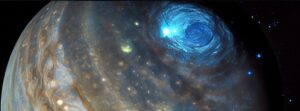Aurorae discovered on all four major moons of Jupiter
A team of astronomers using the W. M. Keck Observatory in Hawaii has discovered that aurorae at visible lengths appear on all four of Jupiter’s major moons, namely Io, Europa, Ganymede, and Callisto. The discovery was made using the High-Resolution Echelle Spectrometer (HIRES) at the Keck Observatory, as well as other high-resolution spectrographs at the Large Binocular Telescope and Apache Point Observatory.

